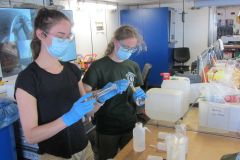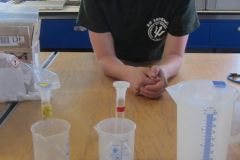
Ocean interfaces under global changes –
Exploring the fate of the Amazon River plume
09.04.2021 – Isotopes: an outlook on element cycling
As we said previously, understanding the Amazon River Plume’s carbon biological pump is of major concern. As the most important sinks of carbon have been found in the nitrogen-limited zone of the Amazon River plume, having a better constrain of the use and transformation of nitrogen in this complex system is relevant for our understanding of the future of planet Earth.
However, describing the cycling of an element is complex because of the number of parameters forcing it (consumption, production, dissolved gases, exchanges between reservoirs, like between ocean and atmosphere.). An interesting way to investigate the major processes and transformations of an element, like nitrogen (N) in our case, is to have a look at stable isotopes (not radioactive ones).
Isotopes of an element are by definition atoms composed of the same number of electrons and protons but of a different number of neutrons. These isotopes - or different versions of the same element - possess similar chemical properties but can differ in their physical ones. N presents two stable isotopes: 14N and 15N, 14N being the most abundant form in nature (> 99 %). The mass differences between 14N and 15N are enough to discriminate between them during physical, chemical and biological processes. Because of its number of neutrons, 15N forms stronger bonds with other atoms that are harder to break. Therefore, the light isotope is often “preferred” and reacts faster. The preference for one isotope relative to another during a reaction is called fractionation and it can be quantified by a fractionation factor. But enough here about complicated background information.
Let’s have a look at phytoplankton living in an environment where both 14N and 15N are available. As it is easier to process, the phytoplankton starts consuming the 14N, leaving the remaining water enriched in 15N. It could therefore be possible to differentiate an environment with phytoplankton from one without! And this only from looking at the ratio between isotopes. In addition, it is also possible to measure exactly how much of a nutrient (e.g. nitrate or ammonium) is taken up by phytoplankton by purposely enriching its environment in 15N (which you can buy, for example as 15N-nitrate), and measuring after an incubation time the changes in phytoplankton isotopic composition. This enrichment technique can be done thanks to nutrients chemically transformed to no longer contain the light isotope.
It gets even more interesting when we know that fractionation is process-specific and varies as a function of environmental conditions. Fractionation leads to changes in the isotopic composition of the product and of the remaining pool. These subtle differences are measurable using isotopic ratios with respect to atmospheric N, enabling us to understand the undergoing of conversion from the substrate to product, making N isotopes a powerful tracer of biogeochemical processes. These isotopic ratios are written with a “δ”, and that is why this sign is so prominent on our logo.
Text: Choisnard N., Umbricht J., Voss M. (all IOW)
| Expedition: | M174 |
| Mission: | MeNARP |
| Start: | 12.04.2021 - Las Palmas |
| Destination: | 31.05.2021 - Emden |

